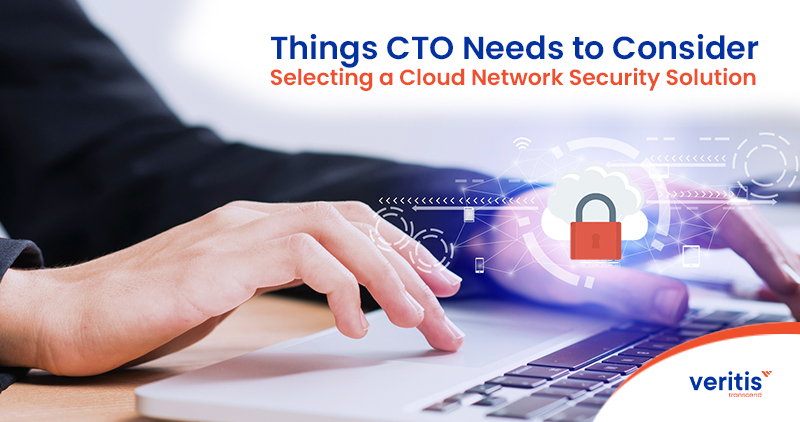
Table of contents
As organizations increasingly migrate their data and applications to the cloud, cyber attackers find new ways to exploit vulnerabilities, gain unauthorized access, and compromise sensitive information. A particularly concerning technique, known as the “watering hole attack,” has evolved within cloud environments, enabling cybercriminals to infiltrate production systems and cause significant harm.
With cloud adoption strategy critical to business growth, securing cloud infrastructure has become more complex. Experts and security consultants recommend a multi layered, comprehensive approach to protect cloud deployments effectively. To help CTOs navigate this challenge, we have outlined key factors to consider when selecting a cloud network security solution. But before diving into the specifics, let’s first understand the fundamentals of cloud network security.
What is Cloud Network Security?

Cloud network security involves implementing measures to prevent unauthorized access to data and applications stored in the cloud. It encompasses tools, policies, and services to safeguard cloud computing environments from internal and external threats.
The growing reliance on cybersecurity services offers enhanced data security and operational efficiency. However, organizations must establish robust security measures tailored to their specific data sensitivity and compliance requirements to fully leverage these advantages.
Useful link: Cloud Implementation Services: Strategy, Solutions and Benefits
Core Pillars of Cloud Network Security:
- Next Generation Firewalls (NGFW): Prevent unauthorized access and filter malicious traffic.
- Microsegmentation: Isolates workloads to reduce the lateral movement of threats.
- Zero Trust Architecture: Enforces continuous verification and least privilege access.
- Secure Access Service Edge (SASE): Converges networking and security into a unified cloud service.
- API Security: Protects the APIs that drive cloud native applications.
- Workload Protection Platforms (CWPP): Secures VMs, containers, and serverless workloads.
- Monitoring & Observability: Enables real time detection, response, and forensics.
Industry Trends and Insights for 2025
- 60% of enterprises will unify their security and networking teams under a single leadership structure (Gartner, 2025).
- 40% of cloud breaches stem from misconfigurations (Forrester, 2025).
- Enterprises adopting zero trust frameworks report a 30 to 40% reduction in breach impact costs (McKinsey, 2025).
According to Gartner’s 2025 forecast, over 60% of enterprises will unify networking and security teams under a single leader to improve agility and risk response. At the same time, Forrester reports that misconfigurations account for nearly 40% of cloud computing security breaches, resulting in organizations incurring millions in remediation costs.
The urgency of the situation is apparent: high profile breaches, such as those at Capital One (2019) and DaVita (2025), have demonstrated the severe consequences of cloud misconfigurations and weak network defenses. These incidents have not only compromised millions of customer records but also highlighted that cloud security is not merely a compliance issue; it’s a critical business continuity issue.
“CTOs must view cloud network security as a board level priority, not an IT afterthought. With distributed networks, zero trust adoption is the only way forward.” McKinsey 2025
Veritis Perspective
Having deployed 600+ enterprise security projects across Fortune 500 organizations, Veritis recommends:
- Adopting zero trust as the default model for all cloud networks.
- Prioritizing automation driven incident response to minimize dwell time.
- Leveraging cloud native security controls from providers while ensuring cross cloud visibility.
Key Factors to Consider When Choosing a Cloud Network Security Solution

Selecting the right cloud security solution requires a thorough evaluation of security capabilities and business needs. Here are the critical aspects CTOs should consider:
1) Advanced Threat Protection
Modern cloud threats extend beyond simple malware, encompassing zero day vulnerabilities, ransomware, and lateral attacks. An effective cloud security automation solution should provide:
- Real time threat intelligence
- Deep packet inspection and traffic analysis
- Sandboxing techniques to isolate suspicious activities
- Protection for both East West (lateral movement) and North South (incoming/outgoing) traffic
2) Seamlessness Communications and Accessibility
The CTO must ensure that everyone is aware of the threat environment, security policies, and processes. The cloud security solution’s user interface should be intuitive and optimized for accessibility. This ensures that both administrators and end users can access the required security protocols. Communication is essential to ensure end users know their obligations and security standards. Once they know what is expected, they will be more aware of their activities and less prone to making mistakes.
3) Robust Encryption Mechanisms
Encryption is critical to protecting cloud stored data from unauthorized access. A strong cloud security solution should:
- Encrypt data both at rest and in transit
- Offer easy to manage encryption controls for administrators
- Prevent unauthorized access even if data is intercepted
Useful link: What is Cloud Computing?
4) Comprehensive Data Protection Policies
Even with robust security measures, human error remains a key vulnerability. CTOs should implement policies that:
- Limit unnecessary data uploads to the cloud
- Outline detailed procedures for handling data breaches
- Define clear security protocols for both administrators and end users
5) Cross Platform Compatibility
Many cloud security solutions are designed for specific operating systems, limiting their effectiveness. To ensure seamless protection, CTOs should:
- Select solutions that support multiple devices and OS environments
- Ensure security measures are uniformly applied across platforms
6) Visibility and Transparency
Comprehensive monitoring and logging are crucial for detecting and responding to threats. The cloud security solution should:
- Provide real time dashboards with actionable insights
- Offer clear and contextualized logs, replacing raw IP addresses with identifiable cloud object names
- Facilitate forensic analysis in case of a breach
7) Scalability and Remote Access Security
As organizations scale, security solutions must adapt accordingly. The ideal solution should:
- Support multi factor authentication for secure remote access
- Include endpoint compliance scanning
- Offer encrypted data transmission to protect users working remotely
8) Integration with SD-WAN
Software defined wide area networks (SD-WAN) are becoming a standard in cloud connectivity. CTOs must ensure their cloud security solution:
- Seamlessly integrates with SD-WAN technology
- Maintains network performance and security without disruptions
The CTO’s Decision Framework for Cloud Network Security
1) Strategic Considerations
- Avoiding vendor lock in while ensuring cross cloud visibility.
- Evaluating long term integration with legacy and emerging technologies.
- Assessing alignment with digital transformation roadmaps.
2) Operational Considerations
- Automation of policies and incident response to reduce human error.
- Scalability to support distributed and global operations.
- Rapid time to detect (TTD) and time to respond (TTR) for advanced threats.
3) Compliance & Governance Considerations
- Meeting requirements of HIPAA, GDPR, SOC 2, and CCPA.
- Generating audit ready reporting for regulators and boards.
- Demonstrating cyber resilience metrics to investors and customers.
Case Study: Cloud Security Overhaul for a Digital Wellness Platform
A prominent fitness and wellness platform turned to Veritis to address growing concerns around cloud security vulnerabilities, user data protection, and compliance risks. With specific instances of data breaches due to fragmented security controls and a lack of real time threat visibility, the client struggled to maintain consistent protection across its multi cloud environment.
Veritis delivered a strategic cybersecurity transformation focused on cloud native solutions, policy driven access controls, and a zero trust framework. By unifying disparate tools and standardizing governance, the platform not only achieved a fortified security posture but also ensured ongoing compliance with data privacy regulations, instilling confidence in the client.
This case highlights why CTOs must prioritize end to end visibility, scalable solutions, and a unified security strategy when evaluating cloud network security options, especially in industries that handle sensitive customer data.
Read the complete case study: Strengthening Digital Well Being with cybersecurity solutions.
Conclusion
As businesses rapidly adopt cybersecurity solutions, securing cloud environments is more critical than ever. CTOs must proactively ensure their organization’s cloud network security solution aligns with industry standards, regulatory requirements, and evolving cyber threats.
At Veritis, we bring over 20 years of industry experience in cloud consulting services, delivering 100% quality assurance through cutting edge solutions. Our team comprises AWS, Azure, and GCP certified cloud consultants, ensuring expertise across multiple cloud environments. Trusted by industry leaders, including Harshi Corp and AWS, we have built a strong reputation for excellence. With a 100% client satisfaction track record, we are committed to providing robust, scalable, and secure cloud network security solutions.
Focusing on threat protection, seamless integration, robust encryption, and scalability can help businesses maintain data integrity, protect sensitive information, and ensure regulatory compliance. A well structured cloud security strategy is no longer optional; it is essential for sustaining business growth and resilience in an increasingly digital world.